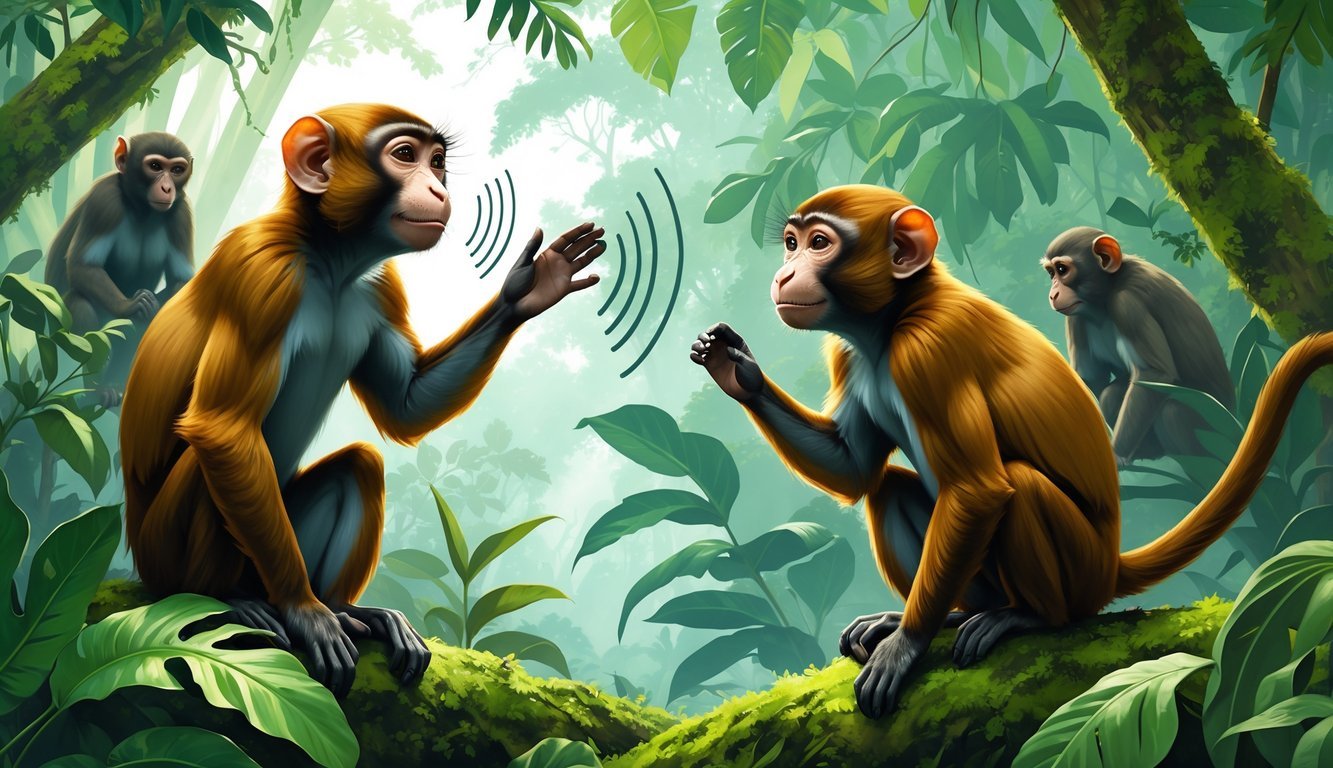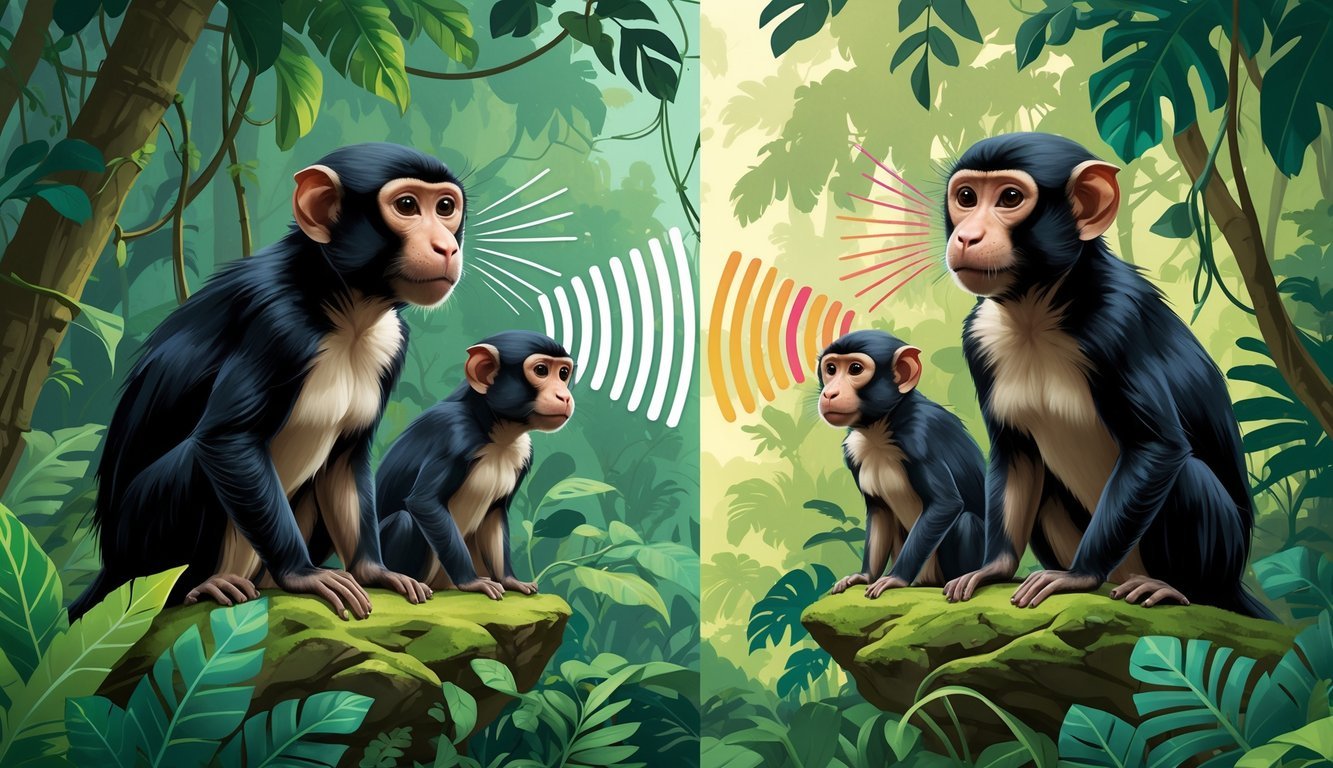PsychNewsDaily Publishers
100 Summit Drive
Burlington, MA, 01803
Telephone: (320) 349-2484
PsychNewsDaily Publishers
100 Summit Drive
Burlington, MA, 01803
Telephone: (320) 349-2484
Tamarins adjust their vocalizations to match neighboring groups, reducing conflict and promoting peaceful coexistence by signaling non-threatening intent through call convergence.

Tamarins live in a world where clear communication can mean the difference between safety and danger. A new study reveals that these small monkeys actually change their “accent” when they wander into the territory of another species.
By copying the calls of other tamarin groups, they dodge conflict and keep things peaceful between different monkey communities.
This behavior lets tamarins share space without fighting over food or shelter. Who would’ve guessed monkeys could be such careful listeners and smooth talkers? Turns out, they’re pretty clever about using sound to get along.
Learning how tamarins tweak their calls gives us a new look at animal communication and the ways species find to cooperate. It might even help us protect them and their forests down the line.

Tamarin monkeys use vocal tricks to keep things calm when they bump into other groups. They change their calls to fit in with neighbors and sidestep fights.
Their voices are surprisingly flexible, and they match calls, though not every group does it the same way.
Honestly, you might not expect tamarin monkeys to have such flexible voices, but red-handed tamarins use a big range of calls. They can change their sounds a lot more than pied tamarins.
This lets them adapt when they wander into another group’s turf. When they change their calls, they sound less threatening.
This vocal flexibility helps them avoid starting trouble over food or space. It’s a smart way to talk with nearby groups without risking a fight.
When tamarins enter new territory, they don’t just make random noises. They listen closely and shift their calls to sound like the other species around.
Scientists call this call convergence. By copying pied tamarins’ calls, red-handed tamarins show they mean no harm.
This helps both groups understand each other. Matching calls works like a peaceful greeting and lowers the odds of aggression.
Not every tamarin changes calls the same way. Red-handed tamarins usually do the mimicking, while pied tamarins rarely copy back.
This asymmetric call convergence shows how one group bends more to avoid conflict. It fits what happens in the wild, where red-handed tamarins seem more flexible to keep the peace and share resources safely.

Tamarins change their vocal calls to cut down on fights and help identify each other across species. This behavior shapes their survival and how researchers try to protect them, especially in the fragile Amazon.
You can spot the evolutionary importance of tamarins changing their accents by how they avoid conflicts. Red-handed tamarins adjust their long calls to sound like pied tamarins when stepping into their neighbors’ territory.
Both species recognize each other this way, and it lowers aggression and territorial squabbles. This kind of behavior ties into evolutionary biology ideas from Darwin, showing how species adapt to survive.
Here, mimicking another species’ accent might help with access to resources and group safety. It’s a neat example of sociobiology, where animal behavior boosts survival in shared habitats.
In the Brazilian Amazon near Manaus, red-handed tamarins and pied tamarins live close together with overlapping territories. To keep things calm, they change their calls when crossing into each other’s space.
This acoustic adaptation signals peaceful intent and helps groups stick together. Behavioral ecology highlights how these monkeys juggle the need for resources with the risk of conflict.
Their calls do more than just say who’s who—they’re a tool to ease tensions out in the wild. If you look closer, you can really appreciate their complicated social lives.
Pied tamarins (Saguinus bicolor) are critically endangered and face shrinking habitats from urban growth and deforestation in the Amazon. Protecting them means saving their territories and understanding their behavior—including how they use calls.
It’s crucial to preserve both species’ habitats in Manaus if we want to keep their natural interactions going. Studies of their vocal patterns help conservationists track populations and spot stress caused by habitat loss.
Supporting this work matters for managing the delicate ecosystems where these primates live.

Tamarins use vocal changes to handle run-ins with other groups. These tweaks help lower the chances of fights and keep peace between different monkey species.
Tamarins adjust their calls by copying the sounds or “accents” of the other group. They end up sounding more familiar and less threatening.
They match the pitch, tone, or rhythm of the other tamarin species nearby.
Researchers recently found tamarins can change their vocal patterns depending on who they meet. This kind of flexibility is pretty rare among wild animals.
Red-handed tamarins, for example, mimic the calls of pied tamarins when they live close by.
Yes, tamarins do mimic other groups’ calls. This helps them avoid fights and share space more peacefully.
By copying accents, tamarins send a signal that they respect the other group’s territory.
The study suggests primates can use vocal changes to manage social tensions. Monkeys really do pay attention to their neighbors’ calls to avoid trouble.
This behavior hints at a thoughtful way of handling relationships between groups.
Tamarin vocal changes show animals can adapt their communication to solve problems. It challenges the old idea that animal calls are fixed and unchanging.
Maybe some animals are even more socially aware than we thought.
When we figure out how tamarins use their calls, we get a clearer picture of what they need in their habitats. That kind of insight helps us shape environments that actually work for them and cut down on unnecessary conflicts.
Researchers can use this information to help different tamarin groups live close together without trouble. It’s a small thing, but understanding their chatter might make a big difference.